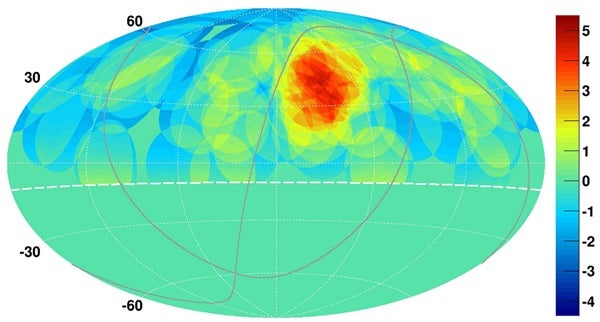“All we see is a blob in the sky, and inside this blob there is all sorts of stuff — various types of objects — that could be the source” of the powerful cosmic rays, he said. “Now we know where to look.”
Thomson said many astrophysicists suspect ultrahigh-energy cosmic rays are generated by active galactic nuclei (AGN) in which material is sucked into a supermassive black hole at the center of a galaxy while other material is spewed away in a beam-like jet known as a blazar. Another possibility is that the highest-energy cosmic rays come from some exploding stars, called “supernovae,” that emit gamma-ray bursts.
Lower-energy cosmic rays come from the Sun, other stars, and exploding stars, but the source or sources of the most energetic cosmic rays has been a decades-long mystery.
The study was conducted by 125 researchers in the Telescope Array project, including Thomson and other University of Utah physicists plus dozens of scientists from the University of Tokyo and other research institutions in Japan, the United States, South Korea, Russia, and Belgium.
Particles from beyond our galaxy
Cosmic rays, discovered in 1912, really are particles, not rays; they can be either bare protons (which are hydrogen nuclei) or the nuclei of heavier elements such as carbon, oxygen, nitrogen, or iron. Thomson and many physicists believe ultrahigh-energy cosmic rays are just protons, although some suspect they could also be helium and nitrogen nuclei.
Besides AGN and gamma-ray emitters, possible sources include noisy radio galaxies, shock waves from colliding galaxies, and even some exotic hypothetical sources like the decay of so-called “cosmic strings” or of massive particles left over from the Big Bang that formed the universe 13.8 billion years ago.
Ultrahigh-energy cosmic rays are those above about 1 billion billion electron volts. If an ultrahigh-energy cosmic ray could penetrate Earth’s atmosphere and hit someone in the head, that single subatomic particle would feel like a fast-pitch baseball to the skull.
Ultrahigh-energy cosmic rays come from beyond our galaxy, which is about 120,000 light-years wide. But 90 percent of them must come from within 300 million light-years because powerful cosmic rays from greater distances are weakened by interactions with the cosmic microwave background radiation — the faint afterglow of the Big Bang — said Charlie Jui from the University of Utah.
The most powerful or highest-energy cosmic ray ever measured was detected over Utah in 1991 by the University of Utah’s Fly’s Eye observatory at the U.S. Army’s Dugway Proving Ground — a predecessor to the Telescope Array. That cosmic-ray particle carried energy of 300 billion billion electron volts.
The Telescope Array uses two methods to detect and measure cosmic rays. At three locations spread across the desert, sets of mirrors called fluorescence detectors watch the skies for faint blue flashes created when incoming cosmic rays hit nitrogen gas molecules in the atmosphere.
Those collisions create a cascade of other collisions with atmospheric gases, resulting in “air showers” of particles that 523 table-like scintillation detectors spaced over 300 square miles (800 square kilometers) of desert detect. In the new study, scientists used 507 of the scintillation detectors to study the ultrahigh-energy cosmic rays, said John Matthews from the University of Utah. The fluorescence detectors helped determine the energy and chemical makeup of the cosmic-ray particles.
A cosmic-ray hotspot
The new study by the Telescope Array research team looked at ultrahigh-energy cosmic rays greater than 57 billion billion electron volts. Thomson said they picked that high cutoff because the highest-energy cosmic rays are bent the least by magnetic fields in space — bending that obscures the directions from which they came and thus the locations of their sources.
The Telescope Array recorded these powerful cosmic rays between May 11, 2008, and May 4, 2013. During the five years, only 72 such particles were detected, confirmed, and analyzed for their energies and source directions.
But 19 of those cosmic rays were detected coming from the direction of the hotspot compared with only 4.5 that would have been expected if the cosmic rays came randomly from all parts of the sky, Jui said.
The hotspot is a 40-degree-diameter circle representing six percent of the northern sky. “We have a quarter of our events in that circle instead of six percent,” Jui said.
According to Thomson, the hotspot is centered in the southwest corner of the constellation Ursa Major, which includes the arrangement of stars known as the Big Dipper.
“The hotspot is a couple of hand widths below the Big Dipper’s handle,” he said. More precisely — although it is not visible through regular telescopes — the hotspot is centered at right ascension 9h47m and declination 43.2°. The hotspot is near the “supergalactic plane” — the rather flattened Virgo supercluster of galaxies. Our Milky Way Galaxy is on the outskirts of the supercluster.
The researchers calculated that the odds that the hotspot is a statistical fluke rather than real are only 1.4 in 10,000.
Observations by the Pierre Auger cosmic ray observatory in Argentina provide evidence for a weaker Southern Hemisphere hotspot. If that proves real, Thomson said cosmic rays in the northern and southern hotspots must come from different sources.
Expanding the search
Jui said a separate study now in progress suggests the distribution of ultrahigh-energy cosmic rays in the northern sky is consistent with the large-scale structure of the universe. This means the cosmic rays tend to come from areas of the universe where matter is concentrated in clusters and superclusters of galaxies.
“It tells us there is at least a good chance these are coming from matter we can see as opposed to a different class of mechanisms where you are producing these particles with exotic processes” such as cosmic strings, he said. “It points us to the next logical step in the search: building a larger detector that collects four times as many [ultrahigh-energy cosmic-ray] events per year. With more events, we are more likely to see structure in that hotspot blob and that may point us toward the real sources.”
Physicists want to expand the size and thus sensitivity of the Telescope Array, doubling the number of table-shaped scintillation detectors to about 1,100 but spacing them farther from one another and thus quadrupling the area across where they are scattered. All the land for the expansion is located north and south of the present observatory.
Researchers hope to obtain $6.4 million needed for the expansion from U.S. and Japanese governments later this year and then finish the expansion in 2016.










